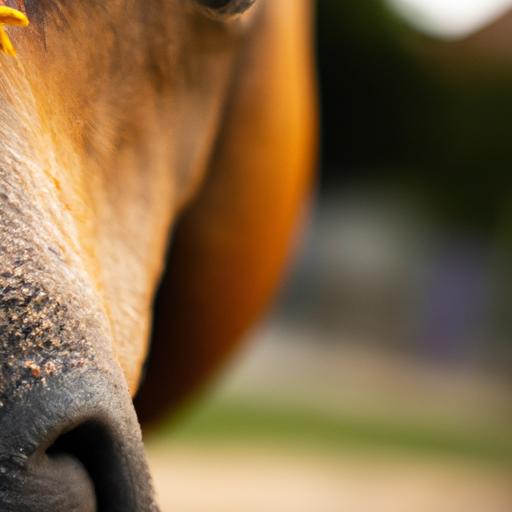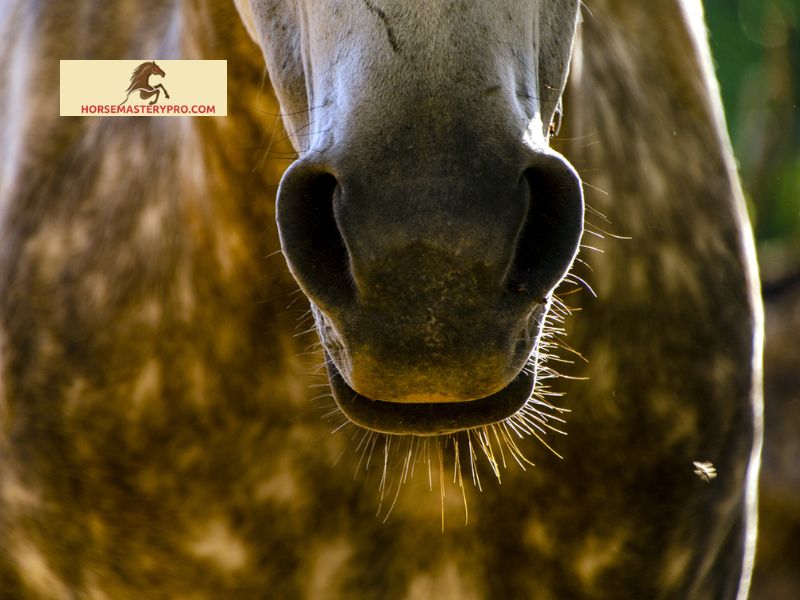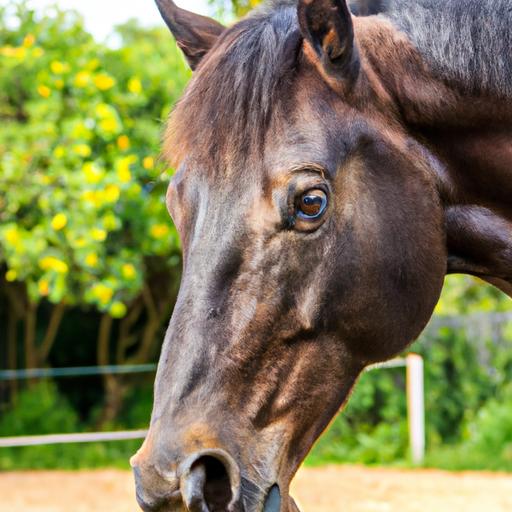Discover effective treatments and management options for horses bleeding from the nose. Learn about first-aid measures, veterinary interventions, rest protocols, and preventive measures.
Have you ever come across a horse with a nosebleed? It can be a startling sight, leaving you wondering what might have caused it and how to address the issue. In this article, I will shed light on the phenomenon of horses bleeding from the nose and delve into the essential aspects of its causes and treatments.
A. Brief Explanation of Horses Bleeding from the Nose

Equine epistaxis, commonly known as horses bleeding from the nose, refers to the occurrence of blood flowing from a horse’s nostrils. While it may seem alarming, it is crucial to understand that nosebleeds in horses can be caused by various factors, ranging from minor injuries to more severe underlying conditions. Recognizing and addressing these causes is vital for the well-being and health of the horse.
B. Importance of Understanding the Causes and Treatments
Understanding the causes and treatments of horses bleeding from the nose is of utmost importance for several reasons. Firstly, it allows horse owners, trainers, and caretakers to promptly identify and address potential health issues. Early detection and appropriate intervention can prevent the condition from worsening and potentially save the horse’s life. Secondly, by comprehending the underlying causes, we can take preventive measures to reduce the risk of future instances. Lastly, solid knowledge on this topic empowers us to provide the necessary care and support to horses experiencing epistaxis, ensuring their overall well-being and a speedy recovery.
In the following sections, we will explore the symptoms, diagnosis, causes, and treatment options related to horses bleeding from the nose. By gaining a comprehensive understanding of this condition, we can equip ourselves with the necessary knowledge and skills to handle such situations effectively.
Stay tuned for the upcoming sections, where we will delve deeper into the symptoms and diagnosis of equine epistaxis, shedding light on potential causes and exploring various treatment and management options to ensure the best possible outcome for our beloved horses.
Check back soon for the next section: “Understanding Equine Epistaxis: Symptoms and Diagnosis.”
Understanding Equine Epistaxis

A. Definition of Equine Epistaxis
Equine epistaxis refers to the occurrence of nosebleeds in horses, characterized by the flow of blood from their nostrils. This condition can range from mild blood-tinged discharge to more severe and profuse bleeding. It is essential to recognize that epistaxis itself is not a diagnosis but rather a symptom of an underlying issue that needs to be identified and addressed.
B. Common Causes of Horses Bleeding from the Nose
There are several potential causes for horses bleeding from the nose. Understanding these causes can help us pinpoint the root of the issue and determine the appropriate course of action. Some common causes include:
- Traumatic Injuries and Accidents: Horses are powerful animals that can sometimes sustain injuries that result in nosebleeds. These injuries can range from minor cuts or abrasions to more severe trauma, such as fractures or puncture wounds.
- Respiratory Conditions and Infections: Certain respiratory conditions, such as pneumonia or sinusitis, can lead to nosebleeds in horses. Infections caused by bacteria, viruses, or fungi can weaken the blood vessels in the nasal passages, making them more prone to bleeding.
- Exercise-Induced Pulmonary Hemorrhage (EIPH): EIPH is a condition commonly observed in performance horses, particularly those engaged in intense exercise. The strenuous activity can cause blood vessels in the lungs to rupture, leading to bleeding that may be expelled through the nostrils.
- Nasal Tumors and Other Abnormalities: In some cases, horses may develop tumors or other abnormalities in their nasal passages, which can disrupt blood flow and result in nosebleeds. These growths can be benign or malignant and require prompt veterinary attention.
C. Prevalence and Potential Risks Associated
While nosebleeds in horses are not uncommon, the prevalence can vary depending on the underlying causes and the population being studied. It is essential to address nosebleeds promptly, as they can indicate more severe health issues or potential risks to the horse’s well-being. Delayed diagnosis or inadequate treatment can lead to complications, including anemia, respiratory distress, or even life-threatening conditions.
Understanding the various causes and associated risks of equine epistaxis is crucial in providing timely and appropriate care for horses experiencing nosebleeds. In the next section, we will explore the symptoms and diagnostic procedures used to identify the underlying causes of this condition.
Stay tuned for the next section: “Symptoms and Diagnosis of Equine Epistaxis.”
Symptoms and Diagnosis

A. Identifying Signs of Equine Epistaxis
When it comes to horses bleeding from the nose, it is essential to recognize the signs that indicate the presence of equine epistaxis. Some common symptoms include:
- Visible blood: The most apparent sign is the presence of blood flowing from the horse’s nostrils. It may appear as a trickle or a more significant flow, depending on the severity of the condition.
- Nasal discharge: Horses experiencing epistaxis often have a nasal discharge that may be tinged with blood. It may range in color from clear to a reddish-brown hue.
- Coughing: Persistent or recurrent coughing can be an additional indicator of equine epistaxis. It occurs due to blood irritating the airways.
- Respiratory distress: Horses may exhibit labored breathing, rapid breathing, or flaring nostrils as a result of the condition.
B. Diagnostic Procedures and Tests Used
If you suspect your horse is bleeding from the nose, it is crucial to seek veterinary assistance promptly. A veterinarian will perform a thorough examination and utilize various diagnostic procedures and tests to determine the underlying cause. These may include:
- Endoscopy: This procedure involves inserting a flexible tube with a camera into the horse’s nostrils or airways to visualize any abnormalities or sources of bleeding.
- Nasal swabs and cultures: These tests help identify potential infections or pathogens that could be causing or contributing to the nosebleeds.
- Blood tests: Analyzing blood samples can provide insights into the horse’s overall health, including checking for indications of anemia or blood clotting disorders.
- Radiography or ultrasound: These imaging techniques can be utilized to examine the nasal passages, sinuses, and surrounding structures for any abnormalities or tumors.
C. Differentiating Between Serious and Non-Serious Cases
Upon diagnosing equine epistaxis, it is essential to differentiate between serious and non-serious cases. While any instance of nosebleeding should be taken seriously, certain factors may help determine the severity. These include the duration and frequency of nosebleeds, the amount of blood lost, and the overall health and behavior of the horse. A veterinarian’s expertise is crucial in making this assessment and guiding appropriate treatment measures.
Understanding the symptoms and diagnostic procedures related to equine epistaxis is vital for early detection and effective intervention. In the next section, we will explore the diverse causes that can lead to horses bleeding from the nose, providing further insights into this concerning condition.
Stay tuned for the next section: “Causes of Horses Bleeding from the Nose.”
Causes of Horses Bleeding from the Nose
When it comes to horses bleeding from the nose, there are several possible causes that we need to be aware of. Understanding these causes is crucial in order to provide appropriate treatment and management. Let’s delve into some common factors that can lead to equine epistaxis:
A. Traumatic Injuries and Accidents
One of the primary causes of nosebleeds in horses is traumatic injuries or accidents. These can range from minor incidents, such as bumping into objects, to more severe head trauma. The forceful impact can damage blood vessels in the nasal passages, resulting in bleeding. It is essential to assess the extent of the injury and provide immediate veterinary attention to prevent further complications.
B. Respiratory Conditions and Infections
Respiratory conditions, such as pneumonia or sinusitis, can also contribute to horses bleeding from the nose. Infections in the respiratory system can cause inflammation and irritation, leading to the rupture of blood vessels. Identifying these underlying conditions and treating them promptly is crucial for the overall health and well-being of the horse.
C. Exercise-Induced Pulmonary Hemorrhage (EIPH)
Exercise-induced pulmonary hemorrhage (EIPH) is a condition commonly observed in athletic horses, particularly during intense physical exertion. EIPH occurs when the tiny blood vessels in the lungs rupture, causing blood to enter the airways and eventually flow through the nostrils. This condition is often associated with strenuous activities, such as racing or high-intensity training. Proper training techniques, appropriate rest periods, and veterinary guidance can help manage and mitigate the risk of EIPH.
D. Nasal Tumors and Other Abnormalities
Although relatively rare, nasal tumors and other abnormalities can also lead to nosebleeds in horses. These growths or structural irregularities can cause obstruction or damage to blood vessels, resulting in bleeding. Timely diagnosis and appropriate veterinary interventions are crucial to address these underlying issues effectively.
By understanding these common causes, we can better identify the root of the problem when horses bleed from their noses. Remember, it is vital to consult with a veterinarian for accurate diagnosis and tailored treatment plans based on the specific cause of epistaxis.
In the next section, we will explore the symptoms and diagnostic procedures used to identify horses bleeding from the nose: “Understanding Equine Epistaxis: Symptoms and Diagnosis.”
Conclusion
In conclusion, understanding the causes and treatments of horses bleeding from the nose, or equine epistaxis, is crucial for the well-being and health of our equine companions. By recognizing the signs and symptoms, we can promptly seek veterinary assistance and provide the necessary care and support.
Throughout this article, we have explored the various aspects of equine epistaxis, including its definition, common causes, and potential risks. We have discussed the importance of early diagnosis through proper symptom identification and diagnostic procedures. Additionally, we have delved into the diverse causes of nosebleeds in horses, ranging from traumatic injuries to respiratory conditions and abnormalities.
When it comes to treatment and management, immediate first-aid measures such as applying pressure and keeping the horse calm can help control bleeding and reduce the risk of further complications. Veterinary interventions, including medications and procedures, are essential for addressing underlying causes and facilitating a speedy recovery. Rest and recovery protocols should be followed to ensure the horse’s well-being and prevent reoccurrence. Lastly, implementing preventive measures, such as regular veterinary check-ups and providing a healthy environment, can significantly reduce the risk of future episodes.
Remember, when horses bleed from the nose, it is essential to seek professional help promptly. The expertise and guidance of veterinarians are crucial in determining the cause and providing appropriate treatment options. By prioritizing the health and well-being of our horses, we can ensure their longevity and happiness.
Thank you for joining me on this journey to understand horses bleeding from the nose. For more information and resources on equine health and well-being, visit horsemasterypro.com. Together, let’s continue to nurture and care for our majestic equine companions.


